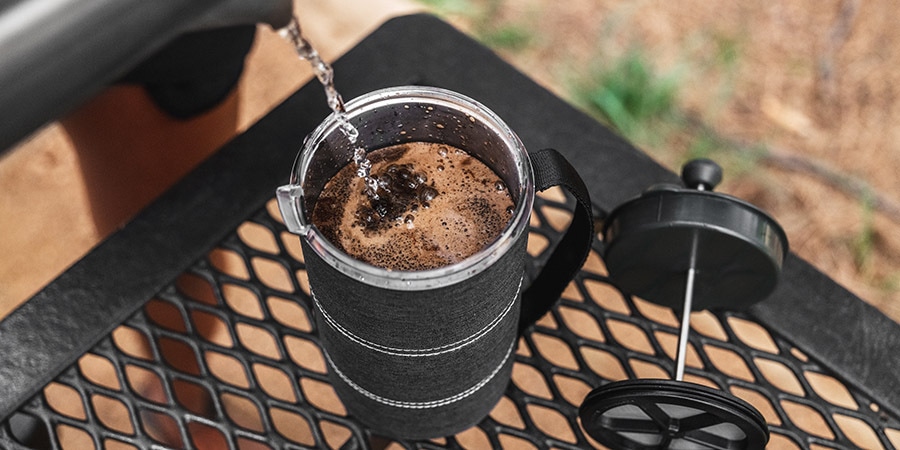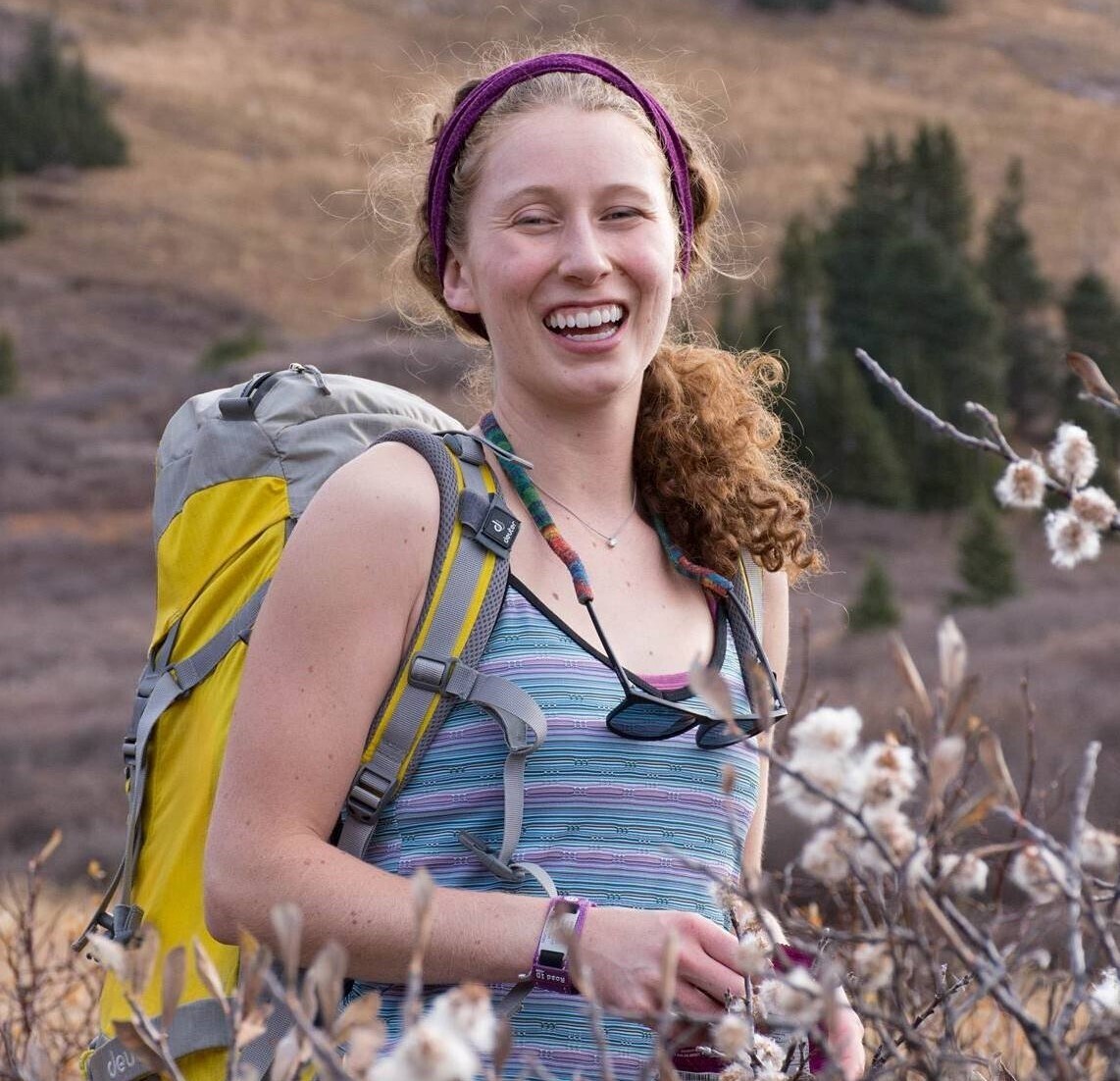The union of wilderness and well-brewed coffee might seem like a tall order, but with the right tools and a bit of knowledge, it's an achievable luxury. From the robust simplicity of a French press to the delicate nuances of a pour-over coffee or the bold intensity of an espresso, there's a brewing style to pair with every palate—and every campsite. And as an added boost, we've also compiled some quick tips for brewing better coffee.
Our 24 testers brewed and sipped more than 200 cups of coffee (not all at the same time, don't worry) to arrive at this list of the six best caffeine-delivery systems sold at REI.
The 6 Best Camp Coffee Makers: Test Results
Find our quick recommendations here or read on for in-depth reviews.
- Best Overall Coffee Maker & Editors' Choice Award Winner: AeroPress Go Travel Coffee Press
- Best Coffee Maker for Backpacking: GSI Outdoors Ultralight Java Drip Coffee Maker
- Best Coffee Press: OXO Campgrounds French Press 2.0
- Best Indestructible Camp Coffee Maker: Stanley Pour Over Set
- Best Coffee Maker for Car Camping: GSI Outdoors Mini Espresso Set
Other Top Performers
Best Overall Coffee Maker & Editor’s Choice Award Winner
AeroPress Go Travel Coffee Press
Score 97
Brew method Manually pressurized
Grind type Fine
Weight 11.5 ounces
Servings 8 fluid ounces
Coffee snobs unanimously agreed that if quality is what you're after, the AeroPress is tough to beat. "Good coffee is worth its weight in gold," proclaimed one of our testers, who has since sworn off any and all other coffee-making devices on the trail. Even in our blind taste tests, our coffee drinkers noted that other cups (including barista-style espresso) paled in comparison to the rich, smooth coffee brewed with this portable system, which received an REI Co-op Editors' Choice Award.
To use it, add one heaping scoop of ground coffee (about 14 grams using the included scoop) into the chamber, add just-off-boil water and stir, then affix the top with the filter and press the brew chamber down, like a coffee press. Cleanup is simple and efficient: Pop out the compressed used coffee grounds and give it a quick rinse. There are more moving parts than many outdoor coffee-making systems, but even those new to the brew method found the process intuitive after their second cup. (AeroPress has an easy-to-use guide for how to brew a hot or cold cup of coffee.) "The lightning-fast brew time (about two minutes) is also ideal for those who don't have the patience to wait around for a standard coffee press," said one first-time AeroPress user after a camping trip in Wyoming.
The Go brews slightly less coffee (8 ounces instead of 20) than the XL, and includes a travel mug with a lid, which the whole system packs neatly into. Testers found the included mug to be useful while backpacking, however most were attached to their own camp mugs and preferred to use the AeroPress mug as a carrying case. Aside from the mug, the system includes a plunger, chamber, filter cap, filter holder, stirrer, scoop and 350 paper filters. A reusable metal AeroPress filter is also available at REI (sold separately), eliminating the need to tote paper.
We would be remiss to talk about the AeroPress without addressing the elephant in the room: Can you really call AeroPress "espresso?" In technical coffee terms, the short answer is no (which is why we describe it as brewing "espresso-style coffee" in the product description). Although many testers referred to AeroPress colloquially as "espresso on-the-go," it doesn't meet the technical requirements for a true shot of espresso. (According to the Specialty Coffee Association of America definition, pulling a shot of espresso requires specific brewing conditions that the AeroPress doesn't meet, notably the amount of pressure and higher water temperature.) Buy here.
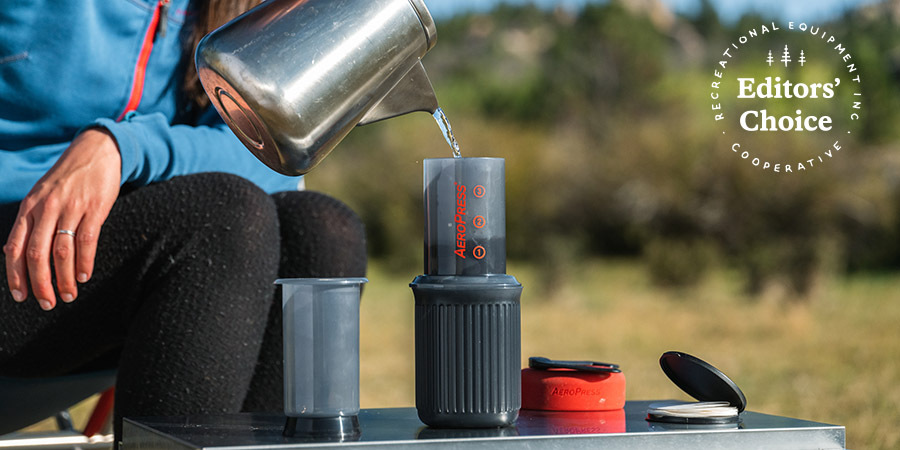
Bottom Line: Unparalleled coffee taste in a compact design makes the AeroPress Go Travel coffee press a great choice for most adventurers.
Testing Stats:
- Cups made: 32
- Favorite beans brewed with: Costa Rica Finca La Margarita from Velo Coffee Roasters in Chattanooga, Tennessee
- Testing states: Colorado, Idaho, Washington, Wyoming
- Best testing story: One tester said he would give up his pillow if it meant he had more space for the AeroPress.
Best Coffee Maker for Backpacking
GSI Outdoors Ultralight Java Drip Coffee Maker
Score 94
Brew method Pour over
Grind type Medium-fine
Weight 0.4 ounce
Servings 8-10 fluid ounces
It doesn't look like much, but the GSI Outdoors Ultralight Java Drip coffee maker brews a quick, no-fuss cup, with a smooth and bold flavor to kick off a long day on the trail. Three spork-size legs clip easily to most camp mugs, then you drape the handkerchief-size pour-over filter and you're in business. "It's fantastically easy to use," said one tester who paired it with his MSR PocketRocket stove on an overnight in the Teton Range. "And as someone who regularly makes pour-over coffee at home, I'm not sure I could tell the difference between a Hario V60 ceramic pour-over setup, and this lightweight Java Drip."
The whole device, which showcased best-in-test packability, weighs just a quarter of an ounce, making it a staple in our testers' backpacking kits. "If that's not light enough for you, you're probably not the kind of person who stops to sniff the coffee beans anyway," one testy tester concluded. But because the Ultralight Java Drip is supported only by its three leg clips, a few testers found they occasionally had to brace the filter with their hand as the hot water weighed it down. (We think this could be mitigated by pouring slower, which would also net a better-tasting cup.) Cleanup is straightforward—just turn the filter inside out and rinse. Buy here.
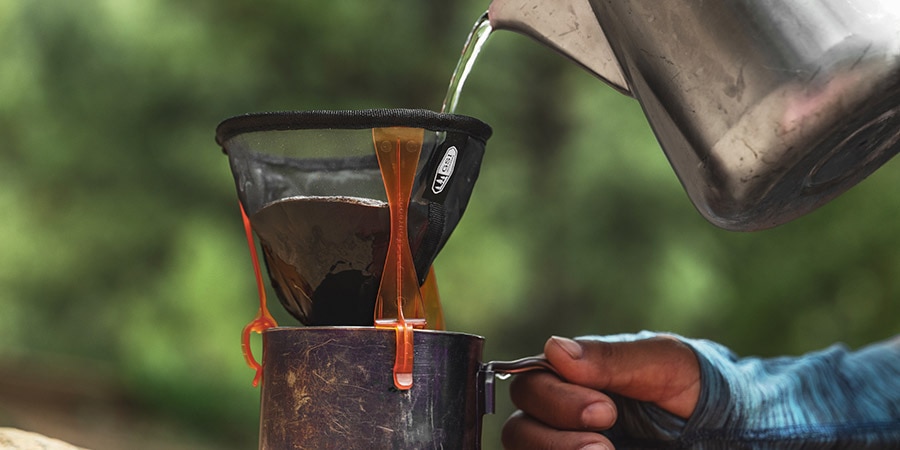
Bottom Line: No-fuss prep makes the GSI Outdoors Ultralight Java Drip a favorite for backpackers and minimalists.
Testing Stats:
- Cups made: 26
- Favorite beans brewed with: Goat Herder from Alpine Air Coffee Roasting in Teton Valley, Idaho
- Testing states: Idaho, Washington, Wyoming
- Best testing story: One tester stuffed the Ultralight Java Drip in his pocket while packing up camp and hiked with it there for the rest of the trip.
Best Coffee Press
OXO Campgrounds French Press 2.0
Score 91
Brew method French press
Grind size Coarse
Weight 1 lb. 0.1 oz.
Servings 32 fluid ounces
Test Reults: If you're looking for a group-friendly and reliable coffee brewer for your next adventure, the OXO Campgrounds French Press 2.0 is our testers' top choice. Beloved for its iconic and simple design, this brewer is remarkably easy to use and brews an impressively flavorful cup.
This affordable French press also scores high marks for durability. The recycled carafe is made of BPA-free Tritan™ Renew food-safe plastic, and is encased in a hard shell for extra protection. "Normally I'm afraid of shattering a French press, but I bet you could drop this one off a ravine and it would survive the fall," one self-described "clumsy" tester says. A fine mesh stainless-steel filter wrapped in silicone creates a tight seal, and additional filters in the lid and spout keep unwanted coffee grounds out of the press's rich, full-bodied coffee. Thanks to a generous 32-ounce capacity and forgiving full-immersion brewing style, you can brew enough cups to satisfy your entire crew with much less effort than it might take to feed them all. Simply scoop 10 tablespoons of coarse-ground coffee into the carafe and fill with hot water up to where the protective shell ends. Place the top on the brewer but don't press the plunger until a 4-minute brewing period has elapsed; then press the plunger all the way to supress the coffee grounds and stop the brewing process. Our testers found that the press pot is a cinch to wipe clean, and knocking out spent grounds is a breeze.
Like most traditional French press pots, this one isn't insulated, so bring your own insulated mugs for chilly mornings. Despite its light weight, its rigid structure feels too bulky for backpacking or ultralight adventures. Buy here.
Bottom Line: The OXO Campgrounds French Press 2.0 offers absurdly easy brewing and great-quality coffee for a group of up to four campers with discerning taste.
Testing Stats:
- Cups made: 48
- Favorite beans brewed with: Creamery seasonal blend from Ruby Roasters in Nelsonville, Wisconsin
- Testing states: Minnesota, Washington, Wisconsin
- Best testing story: One tester who loves camp cooking spent a morning flipping campfire pancakes and simultaneously pressing batches of coffee to feed and caffeinate a group of four.
Best Indestructible Camp Coffee Maker
Stanley Pour Over Set
Score 89
Brew method Drip
Grind size Medium-coarse
Weight 1 lb. 7.4 oz.
Servings 12 fluid ounces
Our testers are real coffee aficionados (and some outdoorsy professional baristas) who demand uncompromising quality even when they're on the road less traveled. That's why they love the Pour Over Set from Stanley. It's crafted from made-to-last, 18/8 stainless steel that's both easy to clean and BPA free. This tough guy can brave the roughest of journeys while delivering the homey comfort of great pour-over coffee. (It's also backed by the Stanley Built for Life™ limited lifetime warranty.)
The straightforward, 20-ounce drip cone is fitted with a reusable metal filter designed to make tasty coffee in three to four minutes—no need to tote paper filters along. Preparation is convenient and, more importantly, forgiving. As with all coffee brewers, finding the grind size that balances sweetness and texture in the cup may require trial and error, but even testers who had to fine-tune grind size to troubleshoot their first brews report successfully pouring cup after cup of coffee that tasted pretty darn good. "I love the built-in filter," says one coffee-pro tester who loves to brew while camping at state parks with family. "It's less wasteful and the stainless steel creates a clean, articulate cup." The all-in-one kit includes a 12-ounce insulated camp/travel mug, so you can stretch the length and warmth of your walks in the wild, stay caffeinated and lose track of time responsibly.
Some caveats: With its rigid design and beefy construction (the set weighs in at nearly two pounds), this isn't the ideal choice for gram-counters. And the brewer can spill over if you try to fill it to its listed capacity. Avoid a piping-hot mess by pouring brew water gradually and giving the cone your undivided attention. (Think of making coffee as your pre-hike meditation.) Buy here.
Bottom Line: Tough hikes call for good coffee and a tough-as-nails brewer, and the Stanley Pour Over Set offers both.
Testing Stats:
- Cups made: 36
- Favorite beans brewed with: Hang Tough Blend from Good Citizen Coffee Co. in Nashville, Tennessee
- Testing states: Minnesota, New York, Washington, Wisconsin
- Best testing story: The cup took a tumble onto some rocks during one tester's fishing trip. While the coffee didn't make it, the mug survived without a scratch. And no fish were harmed. (No fish were caught, either.)
Best Coffee Maker for Car Camping
GSI Outdoors Mini Espresso Set
Score 90
Brew method Percolation
Grind size Fine
Weight 11 ounces
Servings 2.5 fluid ounces
No fuss, no muss—said no one ever about brewing espresso in the wilderness. Until now. This Mini Espresso Set from GSI Outdoors is the waking dream of pinky-up coffee enthusiasts who also love game-changing gear. Now it's possible to raise those pinkies tent-side.
The espresso set comes in a compact, hard-shell foam carrying case that is tough enough to Tetris into your pack or camp kitchen kit without worry. Testers unanimously agreed that the espresso-strength coffee this little brewer churns out is of surprisingly exceptional quality, standing well on its own as a quick shot or stretched with hot water or milk. An early tester partial to Americanos affirms that it's "surprisingly forgiving even with pre-ground coffee." Set it on your stove: The hot, steam-pressurized water brews supercharged coffee in around four minutes, no paper filters needed. This single-serve marvel makes it easy to customize drinks, whether you're caffeinating alone or in a group.
One notable quirk: The handle on the stainless-steel demitasse (included) can get pretty toasty if left on the brewer while it's heating. One tester recommends waiting to put the cup in place until right before percolation begins. (The gurgling sounds should cue you in.) There's also occasional splatter during brewing: Dial the heat down a notch to prevent a hot mess. Buy here.
Bottom Line: The fastest way to smooth out mornings while "roughing it" is with speedy, strong espresso from the GSI Outdoors Mini Espresso Set.
Testing Stats:
- Cups made: 38
- Favorite beans brewed with: Neon Espresso Blend from Dogwood Coffee in Saint Paul, Minnesota
- Testing states: Minnesota, Wisconsin
- Best testing story: One tester vigorously whisks a teaspoonful of brown sugar into their espresso directly after brewing, making a frothy and sweet outdoors version of a Cuban coffee.
Other Top Performers
Honorable Mention
GSI Outdoors Glacier Stainless Steel 6-Cup Percolator
Score 88
Brew method Percolator
Grind type Coarse
Weight 1 lb. 4.1 oz.
Servings 48 fl. oz.
If you're making coffee for a crowd, this percolator from GSI Outdoors is the quickest and easiest way to brew six cups. You simply put coarse grounds inside the chamber (GSI recommends 2 tablespoons for every 6 cups of water, but our testers thought it tasted better when made a bit stronger), place it inside the water-filled kettle, then let it percolate over a stove for four to eight minutes. Coffee snobs likely won't be wowed by the taste, but "it's a quantity-over-quality kind of device that's nice to have on hand," says one tester. This percolator scored high marks for durability, thanks to 18/8 stainless steel that's rustproof and abrasion-resistant. The steel also maintained even heating while on a gas burner, and the silicone grip helps protect your hands when you're ready to pour. Buy here.
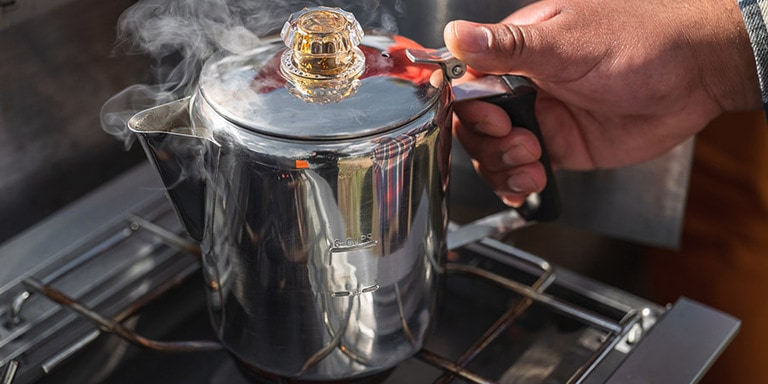
Brewing Advice
Regardless of how or where you brew, making a delicious cup of coffee requires balancing three variables: coffee-to-water ratio, grind size and water. When you get that balance right, making a good cuppa can be a magical part of the camping ritual.
Coffee-to-Water Ratio
If coffee and water are your ingredients, then the coffee-to-water ratio is your recipe, the key to your brew's strength and flavor. Use a lot of coffee relative to the amount of water and your brew will be strong. Less coffee will give you a milder cup. Coffee professionals generally recommend a ratio of somewhere between 15 to 18 parts water to every one part coffee (in other words, one gram of coffee for every 15 to 18 grams of water). For camping, one tablespoon yields roughly five to seven grams of coffee. As a starting point, try two tablespoons of coffee grounds for every six ounces of brewing water. This basic ratio can help you create a balanced cup with sweetness and nuanced flavor.
Grind Size
The next most critical variable to tweak for your perfect brew is the grind size, or how coarse or fine the grounds are. Let's use a cooking metaphor to demonstrate the importance of grind size. Consider how you cut your ingredients when you're preparing a meal: Bigger pieces of potato cook slower than smaller ones.
Similarly, coarser-ground coffee tends to brew slower than finer-ground coffee, as the particle size determines how quickly hot water can extract coffee flavor during the process. That's why a finer grind is used for quick-brewing espresso; a medium grind is ideal for drip coffee makers' moderate brew times (both electric and pour-over); and a coarse grind is best for longer brew methods like French press or cold brew.
If your finished coffee tastes too bitter, it might be over-extracted. This is the result of the water spending too much time absorbing flavors from the grounds, which can happen if your grind is too fine. If the coffee tastes somewhat sour, on the other hand, it's likely under-extracted, which can be caused by water passing quickly through grounds that are too coarse. Adjusting the size of the grind can help you dial in the perfect extraction and achieve the right balance of acidity, sweetness and pleasant bitterness.
To ensure the best taste, before you go camping, think about the method you'll be using, and perhaps even brew a few cups before you hit the trail. Most roasters recommend a grind size to get you started, but you may need to make some small adjustments to get it just right. If you pack a portable coffee grinder, you can change your grind size on the fly. If you're bringing pre-ground coffee, grind more than you need (just in case) and store it in an airtight container.
Water
Water makes up more than 98% of your coffee, so its quality greatly affects the final flavor. Clean, good-tasting water means a better-tasting cup of coffee, plain and simple. Note that any impurities or minerals in your water can interfere with the coffee's extraction and aromatic compounds. If you're packing your own for drinking and brewing, bring more than you think you'll need. If you plan to find water sources near camp, bring a water filter or purifier. (Related reading: How to Choose a Water Filter or Purifier and How to Treat Water in the Backcountry)
Water temperature is also key for quality brewing. According to the Specialty Coffee Association, the optimal temperature for brewing coffee is between 200°F and 210°F (90°C-96°C). You'll likely travel without a temperature-controlled kettle, but the good news is you can still aim for the right brewing temperature at camp. When boiling water over a campfire or with a camp stove, allowing the water to rest away from the heat for about 30 seconds will typically drop it into range. (Related reading: How to Choose a Backpacking Stove)
Quick tip: Water boils at a lower temperature at higher elevations, which can lead to a sour-tasting under-extraction. If this happens, consider grinding a bit finer or letting the coffee steep a little longer.
Buying Advice
Many coffee drinkers already have a preferred brew method, and if that's the case, consider sticking with what you know. Others, however, love to experiment with new techniques and flavors as a way of making camp meals particularly special. If you're choosing a new coffee maker for your outdoor explorations, you'll want to consider how portable and durable it is, how much volume you'll want to brew and what other tools might be necessary to pack. The type of adventure you have planned and what you have access to while you're at camp are also considerations.
Here are a few factors to account for when planning out your camp coffee routine.
Portability
There's a pretty big range in portability of the coffee devices in this guide. If you're hauling all your gear on your back, opt for lightweight coffee makers that are easy to pack. Collapsible pour-over devices like the GSI Outdoors Ultralight Java Drip are ideal for situations where space and weight matter.
Options like the AeroPress Go, OXO Campgrounds French Press 2.0 and Stanley Pour Over Set are slightly bulkier and heavier, although some hikers will choose to carry a little extra weight in order to achieve their perfect cup of coffee.
If you're car camping and have the space, anything goes—but the GSI Outdoors Mini Espresso Set is the ultimate clutch move.
Group Size
Brewing for one or two? A single-serving device like the AeroPress GO Travel and GSI Outdoors Ultralight Java Drip are ideal. The Stanley Pour Over Set is a great solo option if you don't mind the extra weight or bulk. If you have more space in your pack or are car camping, treat yourself to espresso from the GSI Outdoors Mini Espresso Set. With a group, these coffee makers will be time consuming, because you have to brew and then clean up for each cup.
The OXO Campgrounds French Press 2.0 and the GSI Outdoors Glacier Stainless-Steel 6-Cup Percolator brew anywhere from 3 to 6 cups at a time, so both are great options if you're trying to satisfy several coffee drinkers.
Other Camp Kitchen Supplies
What camp kitchen supplies will you have access to? Does your device require a stovetop, like the GSI Outdoors Mini Espresso Set and GSI Outdoors Glacier Stainless-Steel 6-Cup Percolator, or can you get away with a small backpacking stove to just boil water?
Some devices like the AeroPress Go and Stanley Pour Over Set have included or built-in mugs so you don't need to carry a separate mug. In contrast, all other devices in this article require you to pack along something to pour your coffee into.
Also, consider how much water you'll need to clean up and rinse your coffee maker. Drip coffee makers like the GSI Outdoors Ultralight Java Drip are great if you have minimal kitchen supplies because you just remove or dump out the filter. (With any device, make sure to pack out your coffee grinds.)
Video: All the Ways to Make Coffee While Camping
Leave No Trace
Whether you're enjoying a fresh mug of French press, a cup of pour over or a rich espresso in the great outdoors, the nuances of brewing only add to the adventure. Let's ensure our coffee rituals don't spoil the landscape we cherish.
Adhere to the Leave No Trace principles and dispose of used grounds responsibly by packing them out with other food waste. Always store your coffee and other perishables in sealed containers to avoid attracting bears.
Methodology
Our dedicated team of 24 testers have forfeited their normal coffee routines to evaluate more than 14 different coffee brewers sold at REI. Blind taste tests, ultralight backpacking trips, quiet car-camping mornings, backyard breakfasts and a few destination coffee hikes provided the ideal settings to evaluate each device on coffee quality, ease of use, portability and cleanup.
Our testers included casual coffee drinkers, former baristas and coffee professionals, and Seattle-born coffee snobs based in Colorado, Idaho, Minnesota, Wisconsin, Utah, Washington and Wyoming.
